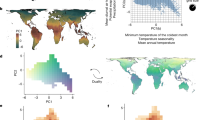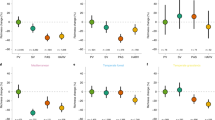Abstract
Arising from: C. D. Thomas et al. Nature 427, 145–148 (2004)); see also communication from Thuiller et al. and communication from Harte et al.; Thomas et al. reply Thomas et al.1 argue, contrary to Sala et al.2, that climate change poses an equal or greater threat to global biodiversity than land-use change. We contest this claim, however, on the grounds that Thomas et al. incorrectly apply species–area relationships.
Similar content being viewed by others
Main
The species–area relationship (S = cAz, where S is the number of species, A is area, c and z are constants, and z is typically 0.25) predicts the number of species in an independently specified area. Instead, Thomas et al.1 use the sum of the ranges of the species themselves to define the sampling area. Their method is circular because the sum of the ranges of S species is automatically correlated with S itself.
The problem with their entire species–area approach is evident in the first of the several, similar methods that Thomas et al.1 propose. Rearranging the species–area formula shows that extinction risk (fraction of original species projected to become extinct) following reduction of independently specified habitat from Aoriginal to Anew is 1 − (Anew/Aoriginal)z. Instead, Thomas et al.1 begin with climate scenarios that predict range loss for individual species. They sum the areas of these species before and after global change to obtain aggregate areas to use in species–area formulae. By arguing that the sum of species' ranges after global change is less than that now, they conclude that extinction risk from global change is large, as great as that from land-use change. This conclusion is premature because the areas used in their calculation are not independent of the number of species. Furthermore, a summation double-counts area occupied by two or more species.
Previous work suggests that species' ranges have responded individualistically to historical climatic changes3. Records of historical climatic changes also show that extinction risk is unevenly distributed with respect to range size4. Hence, summing ranges does not correctly aggregate extinction risk across species because each species is equally weighted in the extinction-risk calculation. Future estimates of extinction risk might be based on working out the number of species whose areas will drop below a critical patch size because of climate change.
The effects of global change on extinction risk are difficult to anticipate. Global warming will increase some habitats and their species-holding capacity, just as warming reduces other habitats. The net effect for biodiversity of these habitat expansions and contractions is not obvious, particularly as species ranges may shift poleward from the tropics5, where the greatest number of species is currently. Although we contest the species–area approach used by Thomas et al.1, we acknowledge species' vulnerability to extinction from climate change6. And economic impacts from climate change also exist: for example, the dislocations caused by sea-level rise and the costs of adjusting to new climate cycles.
References
Thomas, C. D. et al. Nature 427, 145–148 (2004).
Sala, O. E. et al. Science 287, 1770–1774 (2000).
Graham, R. W. et al. Science 272, 1601–1606 (1996).
Jablonski, D. Science 231, 129–133 (1986).
Root, T. L. et al. Nature 421, 57–60 (2003).
Williams, S. E., Bolitho, E. E. & Fox, S. Proc. R. Soc. Lond. B 270, 1887–1892 (2003).
Author information
Authors and Affiliations
Corresponding author
Rights and permissions
About this article
Cite this article
Buckley, L., Roughgarden, J. Effects of changes in climate and land use. Nature 430, 34 (2004). https://doi.org/10.1038/nature02717
Issue Date:
DOI: https://doi.org/10.1038/nature02717
This article is cited by
-
Evidence and mapping of extinction debts for global forest-dwelling reptiles, amphibians and mammals
Scientific Reports (2017)
-
Response of carabid beetles (Coleoptera: Carabidae) and spiders (Araneae) to coastal heathland succession
Biodiversity and Conservation (2011)
-
Increasing impacts of climate change upon ecosystems with increasing global mean temperature rise
Climatic Change (2011)
-
Preliminary global assessment of terrestrial biodiversity consequences of sea-level rise mediated by climate change
Biodiversity and Conservation (2010)
-
Uncertainty in predictions of extinction risk/Effects of changes in climate and land use/Climate change and extinction risk (reply)
Nature (2004)
Comments
By submitting a comment you agree to abide by our Terms and Community Guidelines. If you find something abusive or that does not comply with our terms or guidelines please flag it as inappropriate.



